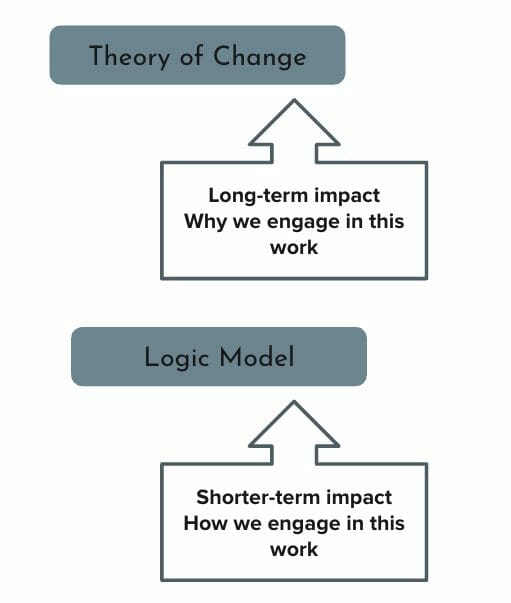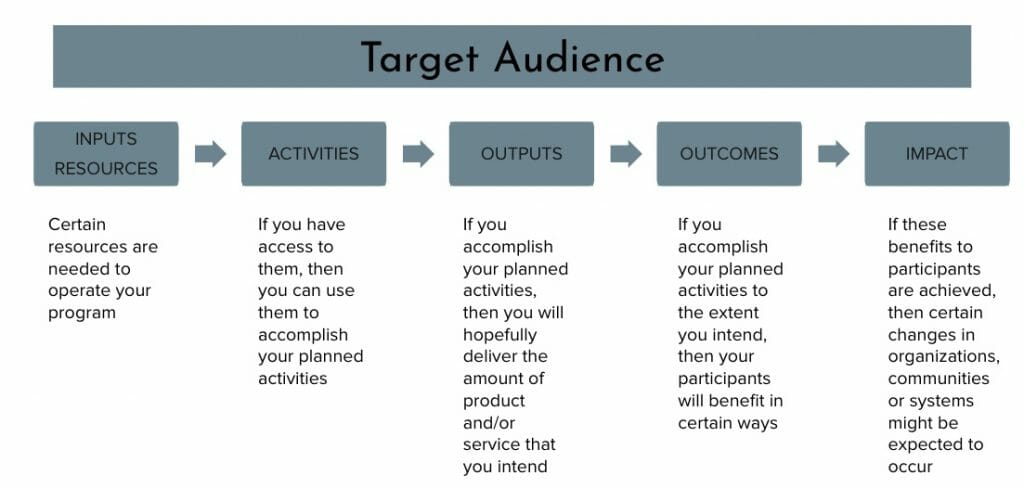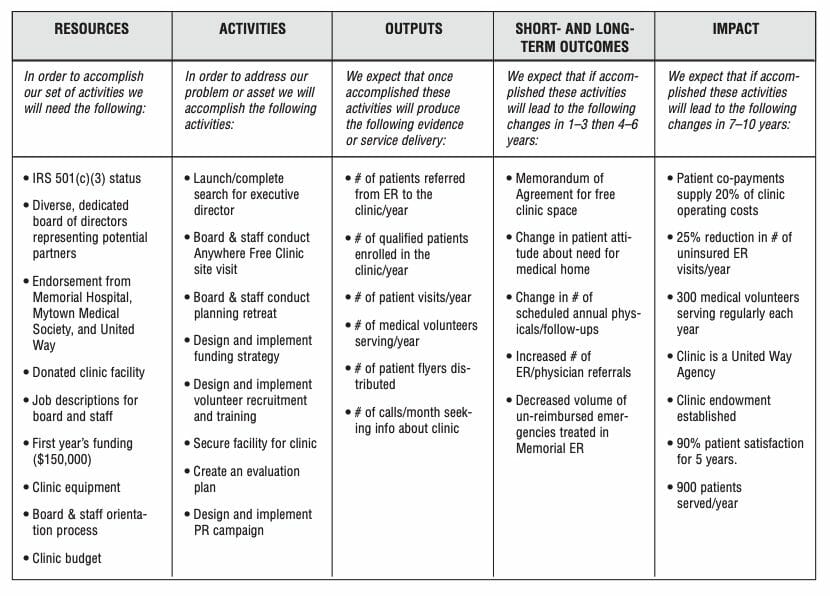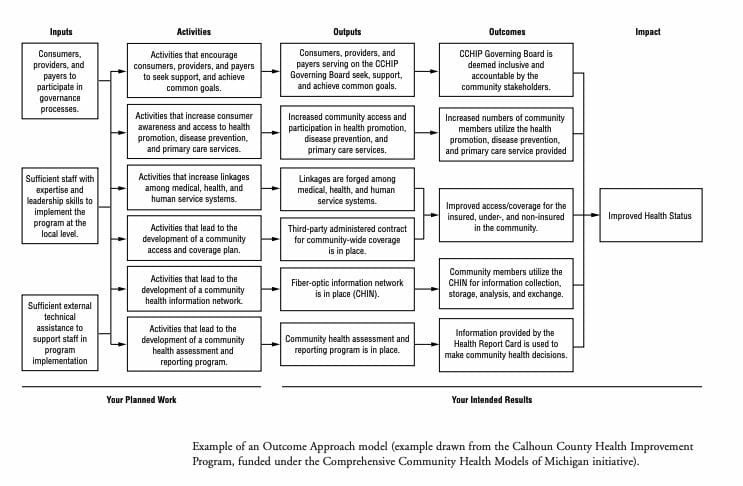What is a Logic Model? How is it different from a Theory of Change? What purpose does it serve? How do you develop a Logic Model for your nonprofit?
These are common questions we receive from nonprofit leaders exploring the development of this important tool. Logic Models are very simple in theory, but the process for creating one can be complex, as it requires research, significant discussion and agreement before it can be finalized.
Even still, it’s worth taking the time to develop a Logic Model if you don’t already have one. The process for creating a Logic Model can be extremely valuable for helping nonprofit stakeholders gain alignment and once it’s done, Logic Models can demonstrate organizational and program goals, along with what it takes to make them a reality.
In this post, we’ll answer your questions about nonprofit Logic Models and then break down the steps you need to follow to create yours.
- What is a Logic Model?
- What Does a Logic Model Include?
- Why Do You Need a Logic Model?
- How Do You Create a Logic Model?
- Logic Model Creation Step 1: Align Around Purpose and Definitions and Gather Data
- Logic Model Creation Step 2: Garner Stakeholder Input
- Logic Model Creation Step 3: Identify Your Impact
- Logic Model Creation Step 4: Brainstorm Outputs and Outcomes
- Logic Model Creation Step 5: Brainstorm Inputs/Resources and Activities
- Logic Model Creation Step 6: Review Brainstormed Items in Each Category and Determine if Anything Needs to be Moved
- Logic Model Creation Step 7: Determine the Measurement Values for Your Outputs
- Logic Model Creation Step 8: Begin Using and Refining Your Logic Model
- Sample Logic Models
What is a Logic Model?
A Logic Model is a systematic and visual way to present and share your understanding of the relationships among the inputs (resources), activities and outputs needed for your organization or program to achieve outcomes and impact. Logic Models are most commonly used for program modeling, design and evaluation.
Logic Models allow for discussion not just about what is happening today, but what is possible in the future. A Logic Model can be created to reflect an existing initiative or program, or it can be used to imagine a new one. Stakeholders can envision and work through multiple scenarios simply by manipulating different components of the Logic Model to see how they may impact intended results.
Because of a Logic Model’s specificity to your organization, it is typically an internally facing tool used to create alignment among leadership, staff and board about current and future program activities and goals. It is also commonly shared with funders to provide clarity about a nonprofit program’s intended results.
It’s important to note that organizations often blur the lines between a Logic Model and a Theory of Change. However, these are two different tools that serve different purposes. A Theory of Change is the long-term goal for the broader social change you’re looking to achieve hand-in-hand with others in your ecosystem, and a map of all of the conditions that are needed to meet it. A Logic Model is a graphical representation of your organization or program, from the resources and activities that will take place, to the deliverables and goals that the program or organization will produce. It is very specific to your organization and/or programs. Your theory of change should be developed first before moving on to create your nonprofit’s logic model.
So let’s dive deeper into the components of a Logic Model.
What Does a Logic Model Include?
Each component of a Logic Model builds toward the next. Think of it this way: the Logic Model includes resources and inputs that support activities, which generate outputs that lead to outcomes, which all together create impact. So let’s break each element of The Logic Model down:
Resources and inputs, as well as activities, describe what you think you need to implement your programs and what you intend to do. Be careful not to mistake these things for results (or outcomes). This is a common misstep of planning teams.
Resources/Inputs
In a Logic Model, the resources and inputs are all of the things that are needed to make your activities possible. Resources and inputs are things like funding, facilities, in-kind resources, program staff, curriculum, etc.
Activities
In a Logic Model, the activities are all of the things you need to do or actions you need to take to drive your outputs, and often define the key elements of your nonprofit’s program or programs. For example, staff training, in-take, evidence-based programs.
Your outputs, outcomes and impact include the program’s or initiative’s desired results.
Outputs
In a Logic Model, outputs are measurable results associated with each one of your activities. For example, hours of training delivered, number of participants served, number of participants retained, etc. If it is easily measured, it is likely an output.
Outcomes
In a Logic Model, the outcomes are the things that are achieved, or the value created, based on the outputs. Many organizations choose to develop short- (1-3 years) and long-term (4-6 years) outcomes as part of their Logic Model.
Example outcomes include things like: the program is reputable, participants continue to come back for additional services, etc.
Impact
In a Logic Model, the impact defines the thing(s) all of the other elements – resources/inputs, activities, outputs and outcomes – are driving toward. For example, the program supports participants in achieving their goals.
The Logic Model is intended to be read from left to right, like a series of “if/then” statements.
Why Do You Need a Logic Model?
Logic Models are valuable to nonprofits of every size and are often used for program modeling, design and evaluation. Smaller organizations may have one Logic Model, while larger organizations may create Logic Models for each one of their programs. They can be used for program design and planning, they can be used to monitor and improve programming, and they can be used to monitor progress toward goals.
For Funders
One of the most common reasons a nonprofit might create a Logic Model is by the request of a funder. This can either be requested along with your funding proposal, or it can be a tool they ask you to use to evaluate and report your performance. Either way, gaining clarity about program value can help nonprofit’s make the case for new or continued investment in your organization and its initiatives.
For Program Stakeholders
Nonprofits also create Logic Models to articulate the value of their programs to stakeholders, other than funders. This can include the individuals and communities nonprofits serve, community partners, legislators and others.
For Nonprofit Teams/Boards
For nonprofit teams and boards, the exercise of creating a Logic Model can often be most valuable, as teams work together to either articulate current programs or think through future ones. It can also be a helpful tool for staff to use for reporting outputs and outcomes to the board.
How Do You Create a Logic Model?
Logic Model Creation Step 1: Align Around Purpose and Definitions and Gather Data
Begin the development of your Logic Model by aligning about the purpose for creating it as well as the intended audience. For example, is the primary purpose evaluative, and do you need it for a funder to articulate information about a current program or initiative? Or, are you reimagining an existing program? Is your Logic Model a reflection of your current reality? Or a depiction of where you’re headed in the future?
It’s really important that the Logic Model development team is aligned about what you’re creating and for whom.
Then, you’ll want to get clear about what a Logic Model is, and what it is not. Remember, a Logic Model is different from a Theory of Change. Confusion between these two important tools can lead planning groups astray. Some groups find it helpful to develop a purpose statement to ensure everyone is on the same page. For example:
We are developing this Logic Model to gain clarity about the issue our programs are designed to address.
Finally, gather any data you might have about existing programs that can be used as inputs for the Logic Model. If you are creating a Logic Model for a new program, it can be helpful to conduct an ecosystem scan to see what programs and supporting data is already available.
Logic Model Creation Step 2: Garner Stakeholder Input
Successful Logic Model development requires the input of your nonprofit’s diverse stakeholders. This includes your funders, who may be requesting you to develop the tool; your board members, who want it for program clarity and reporting; the individuals you serve, who want to better understand your services; and more.
Leveraging surveys, focus groups and listening sessions throughout the Logic Model development process ensures you’re integrating perspectives from within and outside your organization in the development of your model.
Logic Model Creation Step 3: Identify Your Impact
While a Logic Model is meant to be read from left to right, it is best to develop it from right to left. Start by determining the impact you are seeking. This should be directly tied to your Logic Model purpose statement. Whether you’re using your Logic Model for program planning, implementation or measurement and evaluation, may change what you ultimately choose as your impact. Many organizations also find it helpful to develop a timeframe for their logic model i.e. “We hope to achieve this impact in 5 years.” While your impact defines what you would ultimately like to achieve, it is not always measurable. Sometimes it’s helpful to identify your impact first, but other times it can be helpful to brainstorm outcomes and outputs first and then to land on your desired impact.
Logic Model Creation Step 4: Brainstorm Outputs and Outcomes
Start this phase by brainstorming as many outputs and outcomes as possible. Worry less about the distinction between the two at this point. These are all of the desired results based on your inputs/resources and activities. Remember, your outputs are measurable and should lead to your outcomes.
Logic Model Creation Step 5: Brainstorm Inputs/Resources and Activities
Next, brainstorm all of the inputs, resources and activities – the planned work – that you will need to drive toward your outputs and outcomes. Consider working backward again, so that for every measurable output, you have an associated activity and for each activity, you have an associated input or resource(s).
Logic Model Creation Step 6: Review Brainstormed Items in Each Category and Determine if Anything Needs to be Moved
At this point, you have a first draft of your Logic Model, but you’ll want to study it to see if anything needs to move categories. Do you have something that’s actually a resource in your activities? Does each one of your outputs have an associated activity? Does your collection of outputs lead to your intended outcomes? Is there anything missing? Use questions like these to add to your Logic Model or move things from category to category.
This is also a great time to review your Logic Model with stakeholders who haven’t been intimately involved in development for their feedback and input.
Logic Model Creation Step 7: Determine the Measurement Values for Your Outputs
Once you have all of your inputs, resources, activities, outputs and outcomes in your Logic Model, you’re ready to assign measurement values for each one of your outputs. These are the indicators you’ll hope to measure on a regular basis to determine if you’re meeting your desired outcomes and ultimately driving impact.
It’s important to remember that your organization operates as part of a larger ecosystem, so your Logic Model is more about documenting your nonprofit’s contribution than it is about proving something.
Logic Model Creation Step 8: Begin Using and Refining Your Logic Model
Your Logic Model should be a living, breathing tool that you use, at least quarterly to evaluate your program activities and results. As you put your Logic Model into practice, you’re testing the assumptions you had during your development process to determine, if in fact, your logic is correct. Your Logic Model should be adjusted as you collect data and learn from real world applications.




